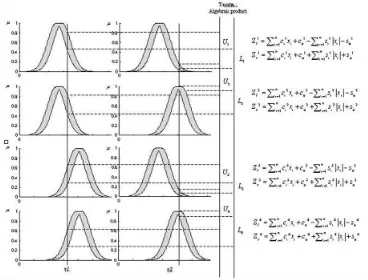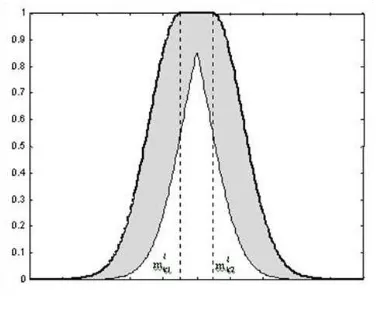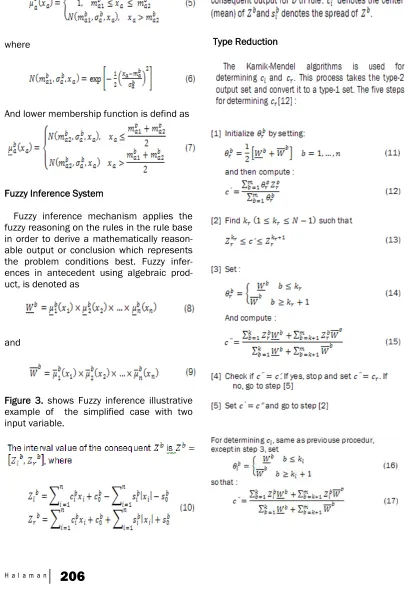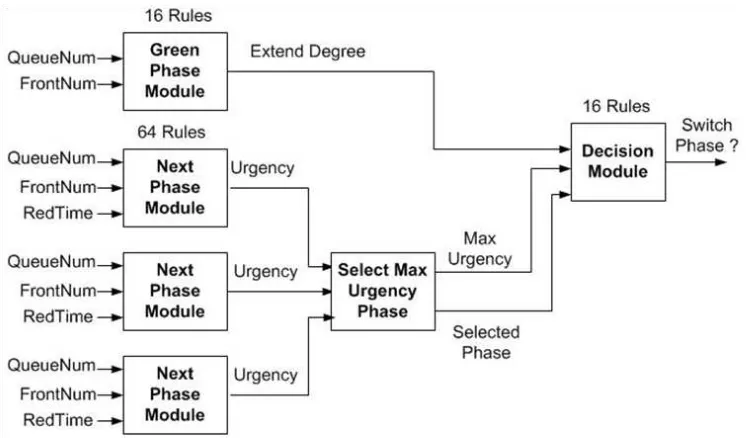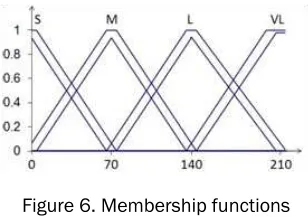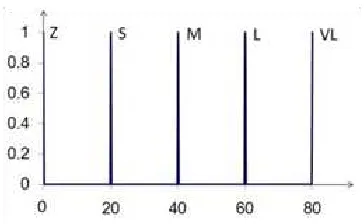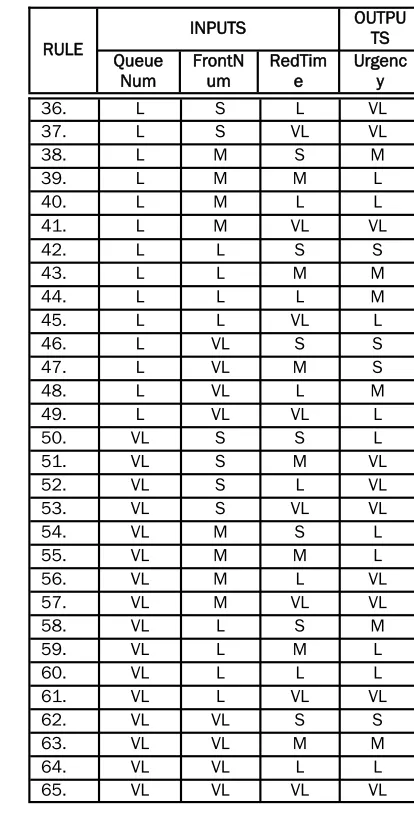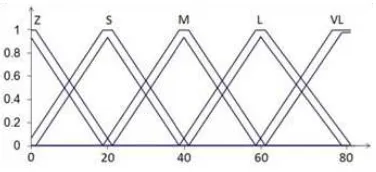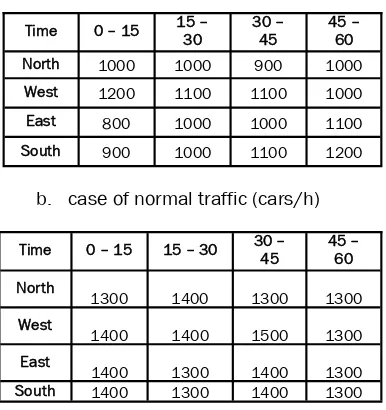This paper presents the design and simulation of an intelligent traffic lights con-troller based on Interval Type 2 Fuzzy System to control a traffic complex inter-section. To control a set of intersection we distribute controls to the controller at each intersection. The controller contains fuzzy next phase module and fuzzy green phase module. The next phase module is working on the phasing, while the green phase module belongs to the green extension level of this multi-level control system. A macroscopic simulator has been developed to simulate the situation of a traffic control intersection. And this simulation software was used to facilitate the evaluation of the proposed Type 2 Fuzzy System strategy. The software allows simulation of different traffic conditions at the intersection. The Type 2 Fuzzy Logic System is compared with Type 1 Fuzzy System and a conven-tional Fixed-Time Controller. The simulation results show that the Type 2 Fuzzy Logic Controller has better performance in the case of time-varying traffic pat-terns and heavy traffic conditions, Interval Tupe-2 Fuzzy algorithm reduced aver-age vehicle delay 13,2 % better than Fixed Timer and 1,6 % than Type 1 Fuzzy algorithm. But Interval Type 2 Fuzzy computation time is more complex than both Fixed Timer and Type 1 Fuzzy algorithm, so Interval Type 2 Fuzzy system takes 3.6 times slower than Fixed Timer and 1.8 slower than Type 1 Fuzzy algo-rithm. In application, Interval Type 2 Fuzzy algorithm needs 17888 units of mem-ory, while Fixed Timer only needs 4840 unit memory and Type 1 Fuzzy algorithm just needs 13032 units memory.
Index Terms – Fuzzy Decision Module, Fuzzy Green Phase Module, Fuzzy Next Phase Module, Interval Type 2 Fuzzy System, Karnik-Mendel algorithms
bidang REKAYASA
INTELLIGENT TRAFFIC LIGHT CONTROL BASED ON INTERVAL TYPE 2 FUZZY SYSTEM
MUHAMMAD ARIA
Department of Electrical Engineering Engineering and Computer Science Faculty
Universitas Komputer Indonesia
INTRODUCTION
In the real world, especially in metropoli-tan areas, there are many intersections and each intersection is located close to its neighborhoods. There are many con-ventional methods for traffic signal control but sometimes they fail to deal with com-plex intersections, time-varying traffic conditions efficiently. Various strategy
based on fuzzy logic system have been studied to control the intersection group [1] - [6]. This paper explores the use of interval type 2 TSK Fuzzy system (T2TSK), which is well known for its powerful in han-dling an uncertainties [7].
Performance of interval type 2 TSK fuzzy then comparing between type 1 TSK Fuzzy and conventional fixed-time controller. Although there are a lot of work on type 2 Fuzzy as discussed in [8] - [10], as far as the author concerns, there is no work on development of T2 TSK Fuzzy is suitable for complex intersection traffic control. Contribution of this paper is to propose T2TSK algorithm suitable for complex intersection traffic control and compare the performance between the interval type 2 TSK Fuzzy and type 1 TSK Fuzzy.
The paper is arranged as follows. Interval type 2 TSK Fuzzy structure is provided in Section II. Fuzzy Logic Traffic Signal Control-lers for Complex Intersections is presented in Section III. Design of traffic simulator are developed in Section IV. The simulation re-sults are provided in Section V. In Section VI, we conclude with conclusion.
T2TSK STRUCTURE
Type-2 fuzzy sets were originally pre-sented by Zadeh in 1975. The new concepts were introduced by Mendel and Liang allow-ing the characterization of a type-2 fuzzy set with a superior membership function and an inferior membership function; these two functions can be represented each one by a type-1 fuzzy set membership function. The interval between these two functions repre-sent the footprint of uncertainty (FOU), which is used to characterize a type-2 fuzzy set. Type-2 fuzzy sets allow us to handle linguistic uncertainties, as typified by the
adage “words can mean different things to different people”.
For type-2 TSK models, there are three possible structure [11]:
1. Antecedents are type-2 fuzzy sets, and consequents are type-1 fuzzy sets. This
is the most general case and we call it Model I.
2. Antecedents are type-2 fuzzy sets, and consequents are crisp number. This is special case or Model I and we call it model II.
3. Antecedents are type-1 Fuzzy sets and consequents are type-1 fuzzy sets. This is another special case of Model I and we call it Model III.
We use Model I to design interval type-2 TSK Fuzzy system in this paper. A schematic diagram of the proposed T2TSK structure is shown in Figure 1., which is organized into i input variables and m rules.
Rule Base
In a first-order type-2 TSK Model I with a rule base of m rules and n input variables, is denoted as
The membership grades
are interval sets to, which denoted as
Fuzzification
This process is transforming the crisp in-put to a type-II fuzzy variable. The primary membership functions for each antecedent are interval type-2 fuzzy systems described by Gaussian primary membership function with uncertain means, denoted as
There are two kinds of type-2 sets. First is a gaussian type-2 fuzzy set, which the membership grade of every domain point is a Gaussian type-1 set contained in [0,1]. Second is an interval type-2 fuzzy set which the membership grade of every domain point is a crisp set whose domian is some interval contained in [0,1]. Figure 2. shows gaussian interval type-2 fuzzy membership function with uncertain means.
where
And lower membership function is defind as
Fuzzy Inference System
Fuzzy inference mechanism applies the fuzzy reasoning on the rules in the rule base in order to derive a mathematically reason-able output or conclusion which represents the problem conditions best. Fuzzy infer-ences in antecedent using algebraic prod-uct, is denoted as
and
Figure 3. shows Fuzzy inference illustrative example of the simplified case with two input variable.
Figure 3. Illustrative example of inference mechanism using algebraic product
Figure 4. Fuzzy Traffic Signal Control
Defuzzification
Since the resultant type-reduced output is an interval type-1 fuzzy set, the output of fuzzy can be calculate using the average of its lower and upper bounds
FUZZY LOGIC TRAFFIC SIGNAL CONTROL-LERS FOR COMPLEX INTERSECTIONS
A fuzzy logic controlled traffic lights uses sensors that count cars. This provides the controller with traffic densities in the lanes and allows a better assessment of changing traffic patterns. As the traffic distributions fluctuate, the fuzzy controller can change the signal light accordingly. The fuzzy logic controller determines whether to extend or terminate the current green phase based on a set of fuzzy rules. The flow diagram of a controller is shown if Figure 4.
The objective of the Fuzzy traffic light con-trollers is to reduce the total delay time of waiting vehicles as well as to avoid heavy traffic congestion and to synchronize the local traffic controller with its neighbors, such as controlling the outgoing vehicles into neighboring traffic controllers. The fuzzy traffic lights controller is designed with a number of useful features so for example is that if a large volume of vehicles are con-gested at a neighboring intersection, the number of vehicles coming into that inter-section will be reduced.
Fuzzy logic traffic signal controllers con-tains three modules and this is as shown in Figure 5. It consist of a Next Phase Module, a Green Phase Module and a Decision Mod-ule. The Next Phase Module observes the condition all the other phases except the green phase. The Select Max Urgency Phase selects the most urgent phase. The Green Phase Module observes the condition of traffic flow of the green phase only. The De-cision Module decides the urgency degree between the Next Phase and the Green Phase Modules. It also decides by how long
to extend the green phase signal or whether to change to other phases. For example, if the Green Phase Module is more urgent than the Next Phase Module, the green sig-nal will be extended. On the other hand, if the Next Phase Module is more urgent than the Green Phase Module, the Decision Mod-ule will change the green phase signal to another phase.
Fuzzy Logic Next Phase Module
The NextPhase Module has 3 inputs and 2 outputs. The 3 inputs are (1) QueueNum (2) FrontNum and (3) RedTime. QueueNum (zero, short, medium, large, very large) re-fers to the number of vehicles remain in a lane during a red light phase. FrontNum (short, medium, large, very large) quantifies the number of vehicles in the link between the affected intersection and the down-stream intersections. Information regarding the quantity of vehicles in the front link, left link and the right link are all sent to the fuzzy controller. This input is important in order to avoid congested links. Another in-put which is considered in our design is re-ferred to as RedTime (short, medium, large, very large). It calculates the number of vehi-cles waiting at a red light. This input is con-sidered as to avoid the drivers waiting too long for the green signal. Figure 6 - Figure 8 shows the membership functions of QueueNum, FrontNum and RedTime.
The Next Phase Module ouputs are Ur-gency. Urgency represents the worsening traffic condition of the selected phase. If the
traffic of the selected phase is rather bad, the Value of Urgency increases. The output fuzzy variable Urgency has been proposed to have 5 membership functions. Figure 9. shows the membership functions of Ur-gency.
For the Select Max Urgency, 2 outputs are considered: (1) Urgency and (2) Phase. To get the value of Urgency of a phase, we
should consider the Urgency of the each lane in that phase. The Urgency values of these lanes are combined as the value of that phase. The phase, which has the high-est Urgency value, will be the next phase after the green phase. Phase refers to the phase selected for the next phase after the green phase.
In this Module, 65 rules have been devel-oped to relate the 3 inputs to the output, Urgency, as shown in Table 1. In this case, the labels Z means Zero, S for Short, M for Medium, L for Long and VL for Very Long
Fuzzy Logic Green Phase Module
The GreenPhase Module observes the traffic conditions of the green phase and it consists of 2 inputs which are (1) QueueNum (2) FrontNum and 1 output which is Extend. QueueNum is the remain-ing vehicles in a lane durremain-ing the green sig-nal. FrontNum is referred to as the number of the vehicles in the link where vehicles will go to this link during the green phase. The output of the GreenPhase Module is Extend which translates into the possibility of ex-tending the green phase. The membership function of these inputs are the same as those in the NextPhase Module as shown in Figure 6 and Figure 7.
The output fuzzy variable, Extend, consists of 5 membership functions. This member-ship function are the same as Urgency membership function as shown in Figure 9. In this module, 17 rules have been devel-oped as given in Table 2
Figure 7. Membership functions for FrontNum
Figure 8. Membership functions for RedTime
Fuzzy Logic Green Phase Module
The GreenPhase Module observes the traffic conditions of the green phase and it consists of 2 inputs which are (1) QueueNum (2) FrontNum and 1 output which is Extend. QueueNum is the remain-ing vehicles in a lane durremain-ing the green sig-nal. FrontNum is referred to as the number of the vehicles in the link where vehicles will go to this link during the green phase. The output of the GreenPhase Module is Extend RULE
INPUTS OUTPU
TS Queue Num FrontN um RedTi me Urgen cy
1. Z Z
2. S S S S
3. S S M S
4. S S L M
5. S S VL L
6. S M S S
7. S M M S
8. S M L M
9. S M VL L
10. S L S S
11. S L M S
12. S L L M
13. S L VL M
14. S VL S S
15. S VL M S
16. S VL L S
17. S VL VL S
18. M S S S
19. M S M M
20. M S L L
21. M S VL VL
22. M M S S
23. M M M M
24. M M L L
25. M M VL L
26. M L S S
27. M L M M
28. M L L M
29. M L VL L
30. M VL S S
31. M VL M S
32. M VL L M
33. M VL VL M
34. L S S M
35. L S M L
36. L S L VL
37. L S VL VL
38. L M S M
39. L M M L
40. L M L L
41. L M VL VL
42. L L S S
43. L L M M
44. L L L M
45. L L VL L
46. L VL S S
47. L VL M S
48. L VL L M
49. L VL VL L
50. VL S S L
51. VL S M VL
52. VL S L VL
53. VL S VL VL
54. VL M S L
55. VL M M L
56. VL M L VL
57. VL M VL VL
58. VL L S M
59. VL L M L
60. VL L L L
61. VL L VL VL
62. VL VL S S
63. VL VL M M
64. VL VL L L
65. VL VL VL VL
RULE
INPUTS OUTPU
which translates into the possibility of ex-tending the green phase. The membership function of these inputs are the same as those in the NextPhase Module as shown in Figure 6 and Figure 7.
The output fuzzy variable, Extend, consists of 5 membership functions. This member-ship function are the same as Urgency membership function as shown in Figure 9. In this module, 17 rules have been devel-oped as given in Table 2.
Fuzzy Logic Decision Module
The Decision Module makes the decision whether to switch to the green phase. Its inputs are the outputs from the NextPhase and GreenPhase Modules which are Ur-gency and Extend as described. These 2 antecedents, Urgency and Extend, are com-pared at every interval and the consequent determines whether to change the phase or extend the green signal. In this case we use Yes for ending the Green signal phase and change to a new phase, and No for continu-ing the Green signal. If Urgency is higher than Extend, it means that the traffic condi-tion for the next phase has heavier traffic than the current green phase, and thus the output will change the phase rather than extend the green signal at the current phase. The graphical representation of Ur-gency and Extend membership functions is presented in Figure 10 and Figure 11.
The rules of the Decision Module are given as in Table 3. In all the three modules of the fuzzy controller, the Sugeno inference method are used in the controllers.
DESIGN OF TRAFFIC SIMULATOR
A simulator for intersection group has been developed to test the developed traffic controller. The simulated intersection model consists of nine intersections. Each intersec-tion is connected with its neighborhoods in the four directions. Each link is two way and have capacity 250 cars. Figure 12. shows the simulated intersection group.
The intersection group are divided into four groups input-links according to the RULE
INPUTS OUTPUTS
Queue
Num FrontNum Urgency
1 Z Z
2 S S S
3 S M S
4 S L S
5 S VL S
6 M S L
7 M M M
8 M L S
9 M VL S
10 L S VL
11 L M L
12 L L M
13 L VL S
14 VL S VL
15 VL M VL
16 VL L L
17 VL VL M
Table 2. Fuzzy Rules of
Figure 10. Membership functions for Urgency
location of them: the north input-links, the west input links, the east input links and the south input links. We give the traffic generation plan to each input-link group, so all input-links in a group have the same plan. Cars are generated according to the given plan of a input link and inserted into the link. In the development of the traffic simulator, the following assumptions are made :
i. the intersection is four way junction with traffic coming from the north, west, east and south directions
ii. when traffic from the north and south moves, traffic from the west and east stops, and viceversa
iii. only passenger cars exist and there is no
obstruction to traffic flow such as cross-walks.
iv. left turning traffic and right turning traffic are 20% of the traffic of a link respec-tively
In this simulation we use the following head-way equation:
SIMULATION RESULTS AND DISCUSSION
Performance of Type 2 Fuzzy Logic System (T2FL) is investigated using simulation stud-ies. The developed controller was compared with Type-1 Fuzzy Logic System (T1FL) and Fixed Time Controller. Simulation was per-formed under 18 situations.
1. Case that the traffics of all input links are same :
(a) 900 cars/h (b) 1100 cars/h (c) 1300 cars/h (d) 1500 cars/h (e) 1700 cars/h (f) 1800 cars/h
2. Case that the traffic changes every 15 minutes
a. case of light traffic (cars/h)
b. case of normal traffic (cars/h)
RULE INPUTS OUTPUTS
EXTEND URGENCY DECISION
1 Z Z No
2 Z S Yes
3 Z M Yes
4 Z L Yes
5 Z VL Yes
6 S Z No
7 S S No
8 S M Yes
9 S L Yes
10 S VL Yes
11 M Z No
12 M S No
13 M M No
14 M L Yes
15 M VL Yes
16 L Z No
17 L S No
18 L M No
19 L L No
20 L VL Yes
21 VL Z No
22 VL S No
23 VL M No
Table 3. Fuzzy Rules of the Decision Module
(19)
Time 0 – 15 15 – 30
30 – 45
45 – 60
North 1000 1000 900 1000
West 1200 1100 1100 1000
East 800 1000 1000 1100
South 900 1000 1100 1200
Time 0 – 15 15 – 30 30 – 45
45 – 60
North
1300 1400 1300 1300
West
1400 1400 1500 1300
East
c. case of heavy traffic (cars/h) The average delay time of a car per inter-section was collected. Average delay values are calculated by using weighted average method considering traffic volumes of ap-proaches and it is expressed as seconds per vehicle unit for each flow.
The simulation results are summarized in and Table 4 and Table 5. But T2FL computation time is more complex than both Fixed Timer and T1FL algorithm. Table Figure 12. Simulated Intersection Group.
Time 0 – 15 15 – 30
30 – 45
45 – 60
North 1600 2000 1600 1900
West 1600 1800 1700 1900
East 1800 1600 1900 1600
South 1600 2000 1700 1800
Case Fixed-Time T1FL T2FL
T1FL Improve-ment than Fixed-Time
T2FL Improve-ment than Fixed-Time
T2FL Improve-ment than
T1FL
1.a
54.3 45.9 50 15.60% 8.00% -9.00%
1.b
55.9 50.4 51.1 9.80% 8.50% -1.40%
1.c
60.5 60.1 55.1 0.60% 9.00% 8.40%
1.d
71.7 72.1 64.7 -0.60% 9.70% 10.20%
1.e
111.5 89.6 88.1 19.70% 21.00% 1.70%
1.f 137.9 106 106.4 23.20% 22.80% -0.40%
6 show the comparison of T2FL, T1FL and fixed-time computation time. So Interval Type 2 TSK Fuzzy system takes 3.6 times slower than Fixed Timer and 1.8 slower than Type 1 TSK Fuzzy algorithm. In application, Interval Type 2 TSK Fuzzy algorithm needs 17888 units of memory, while Fixed Timer only needs 4840 unit memory and Type 1 TSK Fuzzy algorithm just needs 13032 units memory.
CONCLUSION
In this paper, we have proposed the traffic controller for complex intersection group based on interval type 2 TSK fuzzy systems and implement the simulator for perform-ance evaluations. To control a set of inter-section, we distribute controls to each troller. Each controller takes charge of con-trolling its traffic signal and cooperating with its neighborhood. Our approach can be eas-ily extended to any situation. According to the simulation studies, results of the fuzzy logic controller is the same as the fixed-time controller in normal traffic flow. But the simulation shows promising results in the cases of heavy traffic and time-varying traf-fic with large variance. In the cases of heavy traffic and time-varying traffic, T2FL algo-rithm reduced average vehicle delay 13,2 %
better than Fixed Timer and 1,6 % than T1FL algorithm. But T2FL computation time is more complex than both Fixed Timer and T1FL algorithm, so T2FL system takes 3.6 times slower than Fixed Timer and 1.8 slower than T1FL algorithm. In application, T2FL needs 17888 units of memory, while Fixed Timer only needs 4840 unit memory and T1FL just needs 13032 units memory.
REFERENCES
Mohammad Hossein Fazel Zarandi, Shab-nam Rezapour, A Fuzzy Signal Controller for Isolated Intersections, Journal of Uncertain System, vol 3, No. 3, pp 174
– 182, 2009
Lin Zhang, Honglong Li, Panos D. Preve-douros, Signal Control for Oversaturated Intersections Using Fuzzy Logic, Trans-portation Research Record, Hawaii, 2004
Jee-Hyong Lee, Keon-Myung Lee, KyoungA Seoing, Chang Bum Kim and Hyung Lee-Kwang, Traffic Control of Intersection Group Based on Fuzzy Logic
Marzuki Khalid, See Chin Liang and Rubiyah Yusof, Control of a Complex Traffic Jun-cion using Fuzzy Inference
Tan Kok Khiang, Marzuki Khalid and Rubi-yah Yusof, Intelligent Traffic Lights Con-trol by Fuzzy Logic
Yetis Sazi Murat, Ergun Gedizlioglu, A New Approach for Fuzzy Traffic Signal Con-trol
Jerry M. Mendel (2007), Type-2 Fuzzy Sets and Systems : An Overview, IEEE Com-putational Intelligence Magazine, vol 2, no.1, pp. 20-29
Ching-Hung Lee, Yu-Ching Lin, and Wei-Yu Lai, Systems Identification Using Type-2 Fuzzy Neural Network (Type-2 FNN) Sys-tems, Proceedings IEEE International Symposium on Computational Intelli-gence in Robotics and Automation, 2003
Oscar Castillo and Patricia Melin, Adaptive Noise Cancellation Using Type-2 Fuzzy Logic and Neural Networks, Prof. of Fuzzy 2004, IEEE press, 2004
Case Fixed-Time T1FL T2FL
2.a 57.0 47.8 48.3
2.b 61.1 56.9 53.0
2.c 110.9 72.6 74.7
Table 5. Average delay time for Case 2
Average of time computation (microsecond)
Fixed-Time 9375
T1FL 18750
T2FL 33854
S. Coupland, M. Gongora, R.I.John, K.Wills, A Comparative Study of Fuzzy Logic Con-trollers for Autonomous Robots
Qilian Liang and Jerry M. Mendel (1999), An Introduction to Type-2 TSK Fuzzy Logic Systems, IEEE International Fuzzy Sys-tems Conference Proceedings, pp III-1534 – III-1539.
Jerry M. Mendel and Hongwei Wu (2007), New Results About the Centroid of An Interval Type-2 Fuzzy Set, Including the Centroid of a Fuzzy Granule, Information Sciences an International Journal, pp 360 – 377.
Salman Mohagheghi (2006), An Interval Type-II Robust Fuzzy Logic Controller for a Static Compensator in a Multimachine Power System, International Joint Con-ference on Neural Networks, pp 2242 – 2244.
Hani Hagras (2007), Type – 2 FLCs : A New Generation of Fuzzy Controllers, IEEE Computational Intelligence Magazine, vol 2, no.1, pp. 30 – 43
Jang, J.-S.R., C.-T. Sun, dan E Mizzutami, Neuro-Fuzzy and Soft Computing, Pren-tice Hall Inc., 1997
G.M.Mendez, M.A. Hernandez (2007), Inter-val Type-1 Non-Singleton Type-2 TSK Fuzzy Logic Systems Using the Hybrid Training Method RLS-BP, IEEE Sympo-sium on Foundations of Computational Intelligence
Jerry M. Mendel, Robert I. John and Feilong Liu (2006), Interval Type-2 Fuzzy Logic Systems Made Simple, IEEE Transac-tions on Fuzzy Systems, vol 14, no 6, pp 808 – 821.
Jerry M. Mendel, Hongwei Wu (2006), 2 Fuzzistics for Symmetric Interval Type-2 Fuzzy Sets: Part 1, Forward Problems, IEEE Transactions on Fuzzy Systems, vol 14, no 6, pp 781 – 792.
Qun Ren, Luc Baron and Marek Balazinski (2006), Type-2 Takagi-Sugeno-Kang Fuzzy Logic Modeling using Subtractive Clustering,
N.N. Karnik and J.M. Mendel (1998), Intro-duction to Type-2 Fuzzy Logic Systems, University of Southern California, Los Angeles
